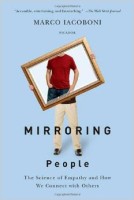I know. You’re waiting to hear about mirror neurons and music and we’ll get to that. But the story of the discovery of mirror neurons is really too good to pass up because it was one of those serendipitous discoveries that has sometimes happened in the history of science. Alexander Fleming’s discovery of penicillin is probably the best-known, but other revolutionary discoveries that happened quite by chance include insulin, quinine, the smallpox vaccine, nitrous oxide and ether as anesthetics, and the invention of the polymerase chain reaction (PCR). In case you don’t know about PCR, it’s sometimes called “molecular photocopying,” and it is used to amplify a single strand of DNA, generating the significant amounts of a sample DNA that are necessary for molecular and genetic analysis, for detection of viruses and bacteria, and of course, for matching criminals to crime scenes as we regularly see on television and in movies.
PCR was discovered by chance in the 1980s and has revolutionized the study of DNA to such an extent that Kary Mullis, the creator of PCR, was awarded the Nobel Prize for Chemistry in 1993. Mirror neurons were discovered by chance in the early 1990s, and several fields have already seen the impact. Marco Iacoboni, mirror neuron researcher at UCLA and author of the  fascinating book, Mirroring People: the new science of how we connect with others, asks “Have you heard of neuroethics, neuromarketing, neuropolitics? You will in the years and decades to come, and research in these fields will be rooted, explicitly or otherwise, in the functions of mirror neurons.” (p. 7) (Re-issued in paperback as Mirroring People: the science of empathy and how we connect with others.)
fascinating book, Mirroring People: the new science of how we connect with others, asks “Have you heard of neuroethics, neuromarketing, neuropolitics? You will in the years and decades to come, and research in these fields will be rooted, explicitly or otherwise, in the functions of mirror neurons.” (p. 7) (Re-issued in paperback as Mirroring People: the science of empathy and how we connect with others.)
V.S. Ramachandran, well-known neurologist and director of the Center for Brain and Cognition at the University of California, San Diego, says that the discovery of mirror neurons “is one of the most important discoveries ever made about the brain. Mirror neurons will do for psychology what DNA did for biology.” So how did this chance discovery come about?
It all started at a lab in Parma, Italy in the late 1980s and early 1990s. A research team, led by neurophysiologist Giacomo Rizzolatti, was studying monkeys to determine the brain networks involved in grasping and manipulating objects such as food. Electrodes had been implanted in the brains of several macaque monkeys in the areas involved in planning and carrying out movements. When the monkey picked up an object, neurons in the brain would fire, a sound that was amplified and heard over a monitor in the lab.
One day, Vittorio Gallese, one of the researchers, was moving around the lab during a break in
the experiments. A monkey was sitting quietly – doing nothing. Suddenly as Gallese picked up something (he doesn’t remember what), he heard a burst of sound from the monitor, signaling activity in the monkey’s brain. But the monkey hadn’t picked up anything – he had only seen Gallese pick up something. Other accounts say someone picked up a peanut or was eating an ice cream cone. You can read a more complete version of the story in Iacoboni’s Mirroring People.
The research team didn’t realize at the time the significance of what had happened (which is why no one remembered later what particular object had been picked up), because it had never occurred to them or to any other scientists that motor neurons could fire when a monkey was merely “seeing” someone else’s actions. That just wasn’t accepted scientific thought. Remember, from the last post, that perception, action, and cognition were thought to be processed in different areas of the brain.
But after a few years and dozens of experiments in the Parma lab as well as in other labs, what had happened on that particular day – and continued to happen in further experiments – became very clear. There was a subset of cells in a monkey’s brain that linked action and perception. Not only did the cells fire when a monkey picked up a peanut, the same cells also fired when the monkey saw someone else pick up a peanut. A different set of cells fired when the monkey broke open the peanut, saw someone break open the peanut, or even heard the peanut shell being broken. Different cells fired for different actions, and action and perception had been found to be linked in the brain.
At first, the researchers referred to these neurons as “monkey see, monkey do” neurons, but they eventually came to be known as mirror neurons. More importantly, a mirror neuron system was discovered in humans as well, although observed through imaging, not through electrodes attached to the brain – for obvious reasons. Not too many people would volunteer to have their skulls cut open and electrodes attached to their brains for the sake of science.
There are skeptics, as has always been the case with any new scientific discovery; some say they find no evidence for mirror neurons in their own research, others that too much is being attributed to the function of mirror neurons. But Rizzolatti suggests that asking the unique function of mirror neurons is not the right question to ask. He says that they don’t have a specific functional role. Instead, they seem to represent some kind of mechanism that maps what we see visually onto the motor counterpart in the brain. And that may play a role in a variety of functions.
The original idea that came out of the Parma research lab is that mirror neurons play a role in understanding actions (other roles were identified later). And Rizzolatti says that’s really not as strange as it sounds. If observing an action gave us visual information only, we would not know what it means to do the action, or have any information about connections between the action we’re observing and other actions that are related. If I saw you riding a bicycle, I would have visual information only. I wouldn’t know what it means to ride a bicycle, or that bicycles can be used to get me to work, or can be used for a lovely Saturday afternoon ride. I am able to have that additional understanding of what it means to ride a bicycle only if, as I’m observing you on the bicycle, that observation is mapped onto my motor system, and that’s what mirror neurons do. So activating this mirror circuit is the only way to provide the observer with experiential comprehension of the action. It creates a rudimentary form of social interaction. I understand your actions because my brain is mirroring those actions in my motor system, making them comprehensible to me.
The theatre world immediately understood the significance of mirror neurons, and a great deal has been written about mirror neurons and acting. In a story attributed to an Israeli actor, the actor noted that “while neuroscientists found the existence of mirror neurons to be extraordinary, they should have asked us actors, who have known – or better, felt – all along that they must have something like these cells in their brains. When I see someone with a painful facial expression, said the actor, I feel her pain inside me.”
And the great director Peter Brook has commented often on mirror neurons, saying that neuroscience has provided a biological explanation for the sharing between actor and spectator – sharing that is the basis on which the theatre evolves – and revolves.
The study of mirror neurons has become one of the most important research areas in neuroscience. Their role in understanding actions is only one research area; they are also being studied for their role in empathy, in autism (a very significant research area), in the evolution of language, in therapies for stroke victims, and, of particular interest to us, in music.
Iacoboni’s book, Mirroring People, is a very interesting read; you may also want to check out the video “Mirror Neurons,” broadcast in 2005 on PBS NOVA.
“Mirror Neurons,” broadcast in 2005 on PBS NOVA.
In the next post, we’ll begin looking at some of the research concerning musicians and mirror neurons and see what those amazing cells mean for learning, teaching and performing music.
4 responses to “Mirror neurons and music, part II: the discovery”
More, more, and be quick about it! Yeah, the reaction of some people early on was typical. The bit about the smallpox vaccination – few are aware that Chinese docs in the Song Dynasty (c. 900-1200 BCE) were vaccinating people vs. smallpox, successfully.
Hi Loren,
Very interesting about the Chinese and smallpox vaccination. I’ll have to look into that – hadn’t heard that before.
This is terrific – the best explication I’ve ever come across. You do such a great job of putting it all in context, as well as clearly laying out the particulars.
Thanks so much, Lyle! Obviously, I don’t write quickly, which is why the posts don’t come more often. But there will be more on mirror neurons soon.